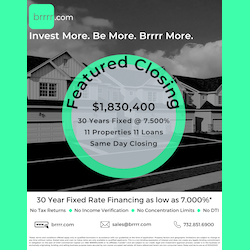Annual Foreign Investment in U.S. Existing-Home Sales Declined 9.6% to $53.3 Billion
Number of existing homes bought by international buyers declined to 84,600 – the fewest since 2009
Washington, D.C., Aug. 01, 2023 (GLOBE NEWSWIRE) —
Key Highlights
- International buyers purchased $53.3 billion worth of U.S. residential properties from April 2022 to March 2023, down 9.6% from the previous year. The 84,600 existing homes sold – the lowest since NAR began tracking in 2009 – retreated 14.2% from the prior year.
- The average ($639,900) and median ($396,400) purchase prices for international buyers were the highest ever recorded by NAR.
- China, Mexico, Canada, India and Colombia were the top five countries of origin by number of U.S. existing homes purchased. The top U.S. destinations for foreign buyers were Florida (23%); California and Texas (12% each); and North Carolina, Arizona and Illinois (4% each).
ADVERTISEMENT
Foreign buyers purchased $53.3 billion worth of U.S. existing homes from April 2022 through March 2023, slipping 9.6% from the previous 12-month period, according to a new report from the National Association of Realtors®. Foreign buyers purchased 84,600 properties, down 14.2% from the prior year and the fewest number of homes bought since 2009, when NAR began tracking this data. Overall, U.S. existing-home sales totaled 5.03 million in 2022, down 17.8% from 2021.
“Sharply lower housing inventory in the U.S. and higher borrowing costs across the world have dented international buyers for two straight years,” said NAR Chief Economist Lawrence Yun. “However, recovering international travel following the end of the pandemic will bring more foreign transactions in coming months and years.”
NAR’s 2023 International Transactions in U.S. Residential Real Estate report surveyed members about transactions with international clients who purchased and sold U.S. residential property from April 2022 through March 2023. Foreign buyers who resided in the U.S. as recent immigrants or who were holding visas that allowed them to live in the U.S. purchased $23.4 billion worth of U.S. existing homes, a 31.4% decrease from the prior year and representing 44% of the dollar volume of purchases. Foreign buyers who lived abroad purchased $29.9 billion worth of existing homes, up 20% from the 12 months prior and accounting for 56% of the dollar volume. International buyers accounted for 2.3% of the $2.3 trillion in existing-home sales during that period.
The average ($639,900) and median ($396,400) existing-home sales prices among international buyers were the highest ever recorded by NAR – and 7% and 8.3% higher, respectively, than the previous year. The increase in prices for foreign buyers reflects the increase in U.S. home prices, as the median sales price for all U.S. existing homes was $384,200. At $1.23 million, Chinese buyers had the highest average purchase price, with a third – 33% – purchasing property in California. In total, 15% percent of foreign buyers purchased properties worth more than $1 million from April 2022 to March 2023.
China and Canada remained first and second in U.S. residential sales dollar volume at $13.6 billion and $6.6 billion, respectively, continuing a trend going back to 2013. Mexico ($4.2 billion), India ($3.4 billion) and Colombia ($0.9 billion) rounded out the top five.
“Home purchases from Chinese buyers increased after China relaxed the world’s strictest pandemic lockdown policy, while buyers from India were helped by the country’s strong GDP growth,” Yun added. “A stronger Mexican peso against the U.S. dollar likely contributed to the rise in sales from Mexican buyers.”
For the 15th consecutive year, Florida remained the top destination for foreign buyers, accounting for 23% of all international purchases. California and Texas tied for second (12% each), followed by North Carolina, Arizona and Illinois (4% each).
ADVERTISEMENT
“Florida, Texas and Arizona continue to attract foreign buyers despite the hot weather conditions during the summer and the significant spike in home prices that began a few years ago,” Yun said.
All-cash sales accounted for 42% of international buyer transactions compared to 26% of all existing-home buyers. Non-resident foreign buyers (52%) were more likely to make an all-cash purchase than resident foreign buyers (32%). Two-thirds of Colombian buyers (67%) made all-cash purchases, the highest share among the top five foreign buyer nations. Approximately half of Canadian (51%) and Chinese (47%) buyers made all-cash purchases. Asian Indian buyers were the least likely to pay all cash, at just 15%.
Half of foreign buyers purchased their property for use as a vacation home, rental property, or both – up from 44% the previous year. Almost three out of five international buyers (59%) purchased detached, single-family homes.
“Fostering economic investment in culturally dynamic communities, businesses, and industry is a top priority for NAR,” said Charlie Dawson, NAR’s vice president of engagement and advocacy outreach. “Our work across the country provides members and their communities with tools, resources and data to identify and highlight international investment opportunities in U.S. real estate. This acts as a key pillar in our efforts to further support local communities to drive economic development in markets across the country. NAR and the Realtor® brand has developed a network of partnerships with over 100 real estate organizations across 77 countries providing growth opportunities by ensuring ethical and accessible markets that allow our members to make direct connections with global real estate professionals and international investors.”
View the full 2023 International Transactions in U.S. Residential Real Estate report at: nar.realtor/research-and-statistics/research-reports/international-transactions-in-u-s-residential-real-estate.
Learn live and in real-time with Realty411. Be sure to register for our next virtual and in-person events. For all the details, please visit Realty411Expo.com or our Eventbrite landing page, CLICK HERE.
















































